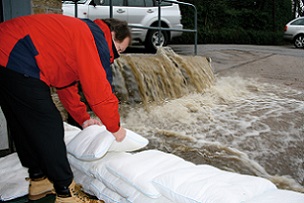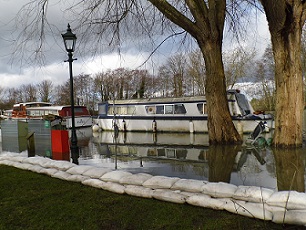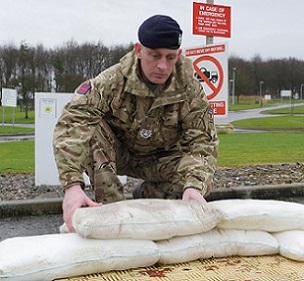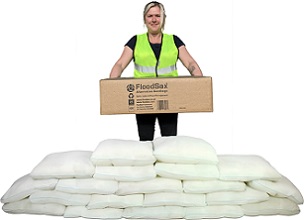 FloodSax alternative sandbags can hold back a torrent of floodwater
FloodSax alternative sandbags can hold back a torrent of floodwater
 FloodSax sandless sandbags saved a caravan park from this overflowing river
FloodSax sandless sandbags saved a caravan park from this overflowing river
 Soldier deploying a FloodSax. The army is sometimes called in if severe flooding is forecast.
Soldier deploying a FloodSax. The army is sometimes called in if severe flooding is forecast.

These 20 FloodSax all came from this one easy-to-carry box. The same amount of sandbags would need a large van or flatback lorry to shift them.
How FloodSax alternative sandbags are perfect flood prevention for homes and businesses
When flooding is imminent you often have only minutes to save your home and business from terrible floodwater damage so you need an instant temporary flood barrier.
FloodSax alternative sandbags are the ultimate flood prevention, flood resilience and flood mitigation product as they are space-saving to store and quick and easy to deploy so provide instant flood protection day and night.
The alternative to FloodSax and other flood prevention devices doesn't bear thinking about ... the misery of being flooded.
Sadly, many people only ask the question 'how can I stop my home from flooding?' too late after they've been flooded.
According to the Association of British Insurers the average claim for a flooded business is £70,000 while the average cost of a flooding claim on home insurance is around £32,000 while all this can be prevented by 20 FloodSax which cost around £140 – about the third of the cost of the flooding excess on home and business insurance policies.
Flooding from outside or internal escapes of water wreck the very fabric of your home – walls will need replastering and floors relaying – as well as destroying your possessions. Any electrical items such as TVs, dishwashers and tumble dryers will need to be thrown away if they are damaged by floodwater.
So it’s absolutely essential to keep the floodwater out in the first place and the Environment Agency is clear that people are responsible for their own flood protection and that specialist flood mitigation and flood resilience products are better than traditional sandbags.
The Environment Agency states: “Don’t assume the authorities will provide you with sand bags in a flood emergency. It's the responsibility of property owners to take appropriate action to protect their property from flooding. Sandbags are relatively ineffective when compared to purpose-built flood protection products. We strongly encourage people to use these products.”
Many people don’t realise that local councils have absolutely no responsibility to provide sandbags and it’s down to people to protect their own properties from flash flooding, river flooding (known as fluvial flooding), groundwater flooding and sewer flooding.
That's why FloodSax - which are also referred to as flood bags, flood sacks or even waterbags - are so important for flood mitigation.
Some councils now realise that FloodSax are so versatile - they can be used indoors too in their dry state to soak up leaks, spills and floods - that they recommend them.
Gosport Borough Council in Hampshire urges its residents to use FloodSax after evaluating the bags. The council adds: “FloodSax have many advantages over traditional sandbags, being easy to store and move, easy to use and, importantly, easy on the environment, having a significantly lower carbon footprint.”
Derbyshire County Council adds: “The county council have a limited supply of FloodSax and these can be provided to members of the public considered to be at risk of flooding for demonstration purposes only. Therefore, the county council recommends residents source their own additional FloodSax should they find that the product works for them.”
FloodSax are used by local councils, facilities managers, utility companies, British Waterways, flood protection groups and countless home and business owners both in the UK and worldwide.
FloodSax are so much easier to use than sandbags they have been officially endorsed by the National Disabled Fire Association that supports disabled people working in the fire service and the wider communities in which they serve.
How FloodSax work and how to build FloodSax into flood-resistant barriers
Build FloodSax into flood protection walls or barriers to stop water getting in through your front door, patio door, garage door or warehouse door.
FloodSax are vacuum-packed in packs of five in easy to carry bags and four packs fit into one cardboard box weighing just 21lbs (9.5kilos)– that’s the equivalent to 20 traditional sandbags and imagine trying to lift and shift them to both store and then putting them in place when a flood is about to happen.
To deploy FloodSax as alternative sandbags when a flood is forecast or is actually happening, simply immerse the FloodSax in 20 litres of water in a large bucket or tub. You could even use a hosepipe or, if time is really critical, use the floodwater itself.
The FloodSax will then expand in around 5 minutes to weigh 20kg (44lbs). A special gelling polymer inside simply absorbs the water and then keeps it in the FloodSax so it can be used for however long the emergency lasts, which could be several months.
Each row of FloodSax will keep out approximately 7 inches of water and usually two or three rows are enough to keep floodwater out. Don’t build them more than one metre (3.2ft) high. Just lay the FloodSax next to one another and then the row on top across the joins below to make it a firm barrier. FloodSax are so heavy and tough, water blasted at them through a firefighting hose won’t shift them.
During torrential rain in West Yorkshire, a row of FloodSax two high kept a deluge of floodwater out of a company’s warehouse. The business had previously been flooded in the warehouse which had led to a £250,000 insurance claim and when the FloodSax kept the floodwater at bay there was high technology electrical equipment valued at £360,000 in the warehouse. The FloodSax stopped any water from getting in and damaging the equipment.